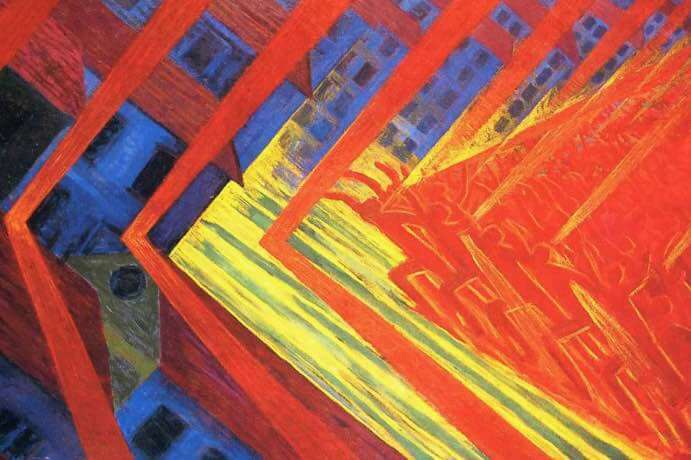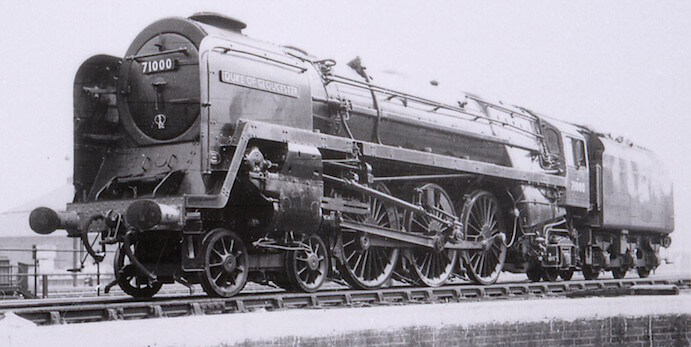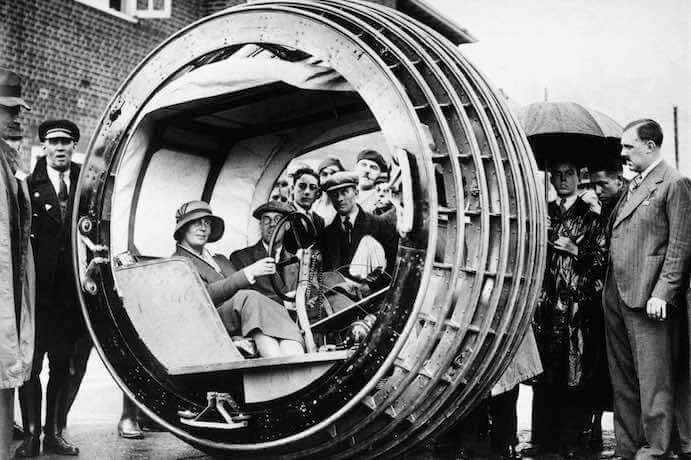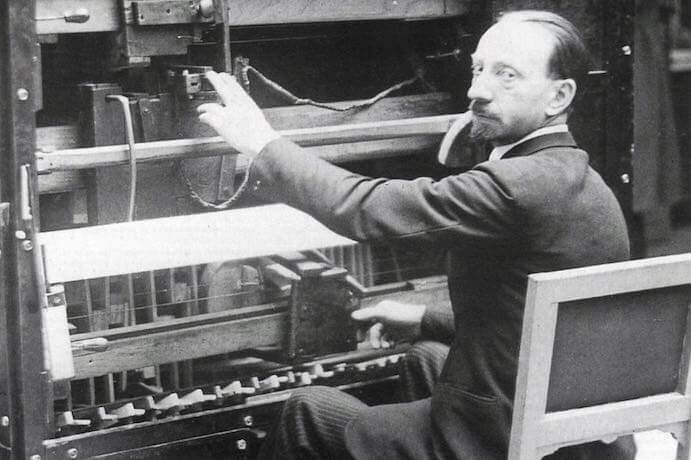Luigi Russolo was that guy at the party.
A painter by trade, Russolo made a second name for himself by being both the life and death of the soirée. He’d often break into vile poetry, destroy textbooks, and worst of all, burn the Italian flag before stomping out to thunderous applause. While crass and obnoxious, his outbursts were pretty much the most fun one could have in a politically-torn Italy. He was always met with a torrent of follow-up invitations the following morning, accompanied by locks of hair if the outburst was memorable enough. Russolo would spend roughly half of the 1910s painting and the other half thoroughly offending Milan’s aristocracy. Us contemporary composers couldn’t be prouder.
Russolo was among the founders of a movement we now call “futurism,” transfixed with the monolithic tones of the modern industry and the European cityscape. His paintings often distort physical reality to show just how eerie life in this new world was. One needs to look no further than his paintings to get a sense of this—abstract shapes jet out of skyscrapers; proto-freeways stretch far into the canvas as if pulling us towards an asymptotic horizon. His works are disquieting, to say the least, and that’s largely what has always attracted me to them. It’s not so much that they demonstrate any future I’d like to live in, but that they demonstrate a future that seems so distinctly pre-WWI. There are no flying cars, androids, or blinking lights in this future. Instead, the cities are bare, mechanically patterned, and oddly sentimental. Russolo had a rather liberal definition of beauty.

Luigi Russolo’s La Rivolta (1911)
In 1913, our anti-hero traveled to Rome to attend a performance by his friend Francesco Pratella. Much to everyone’s surprise, Pratella’s piece didn’t feature any familiar instrumentation. Instead, the orchestra made use of a variety of alien objects that produced sounds that grated, screeched, and most importantly, offended. Just months before Stravinsky’s Rite would cause its own historical ruckus, Pratella’s orchestra played an aesthetic just as new and unsettling as the newly-installed Italian autocracy (perhaps modern U.S. citizens can identify). After the concert, an especially giddy Russolo penned a ten-page letter to the composer. This futurist manifesto, “The Art of Noises,” became, perhaps frustratingly, the painter’s best known contribution to the creative world. While nobody is quite sure what went on in Russolo’s head, the concert prompted him to recontextualize virtually every pre-existing musical conception he had. He writes:
“Ancient life was all silence. In the nineteenth century, with the invention of the machine, Noise was born. Today, Noise triumphs and reigns supreme over the sensibilities of men.”
The enthusiastic Russolo stresses that the concept of “noise” is not only subjective, it’s one that humans actively created. In fact, he goes as far as to prescribe an event that redefined the term: the invention of the steam engine. While the Industrial Revolution is most frequently remembered as the period that changed the meaning of the physical commodity, we rarely consider how it shaped the ways we hear the world. To your pre-steam engine John Smith, the sounds of the world were almost entirely naturally driven. With the sporadic exceptions of thunderstorms, earthquakes, or rocky seas, the sonic palette available was decisively short, quiet, and monochromatic. The steam engine, in this sense, changed our definition of what music could be—just as much as the invention of the bone flute took us into a world of instrumentation, Perotin’s polyphony plunged us into a world of counterpoint, or Haydn’s symphonies introduced us to the timbral possibilities of the orchestra. Trains forever changed the aesthetic of musical language. Thank you, trains.

The Duke of Gloucester (1955)
As steam engines sputtered into action across Europe, they brought with them a new color of sound—one that was arguably more varied and nuanced than anything that preceded it. Whether or not the sounds of industrialization were pleasurable wasn’t of much interest to Russolo. Instead, he logically concluded that music from a pre-industrial era was never composed with the ear of a noise-conscious human. The music of Hildegard, Machaut, and Bach was created in a world with a much more limited sonic palette. For us in 2017, it’s music with timbral training wheels.
Writes Russolo, “Each sound carries with it a nucleus of foreknown and foregone sensations predisposing the auditor to boredom, in spite of all the efforts of innovating composers. All of us have liked and enjoyed the harmonies of the great masters. For years, Beethoven and Wagner have deliciously shaken our hearts. Now we are fed up with them. This is why we get infinitely more pleasure imagining combinations of the sounds of trolleys, autos and other vehicles, and loud crowds, than listening once more, for instance, to the heroic or pastoral symphonies.”
Logically, to make new music for a 20th century ear required a new family of instruments. For the rest of his life, Russolo curated a menagerie of bizarre, homemade noisemakers. His house was soon filled floor to ceiling with his metal scrapers, gratuitously oversized strings, and mysterious boxes with hand cranks. It is presumed that the Italian aristocrats stopped inviting him to parties at this time.
It has been over a century since Russolo penned his letter, and any walk through any 21st century city is an obvious sign that our sonic world has only grown since then. In a post-Russolo world, we have seen the ubiquitous permeation of recorded sound, the chirps and bleeps of electronics, and the aliased artifacts of digital noise. While our world sounds nothing like Russolo’s, it’s curious to notice that our orchestras still perfectly resemble those of 1913. With all respects to Dr. Adler, our orchestras should be viewed as time capsules. Even the most recent common addition, the tuba, was only born in 1908 (though it does look great for its age). Regardless of the kinds of music our modern orchestras play, they barely have the vocabulary of a child from the post-WWI baby boom. This isn’t necessarily a bad thing, of course. Our orchestras just have a bit of a dated accent.

The Futurists, having fun. Presumably.
My job, at least for the next year, is to be the orchestra’s vocal coach.
As it happens, there are hundreds who share my, and Russolo’s, frustration. Hundreds of people who, like the futurists, are working tirelessly to conceive, construct, and hardest of all, find acceptance for, new musical instruments. Musical inventors are hiding all over the world— from abandoned silos in Switzerland to a landfill in Paraguay. You can find them in Guatemalan laboratories, Korean circus sideshows, and Italian alpine gardens. Unfortunately, there is little writing about these projects. At least, until now.
A few months ago, I was graciously (and rather surprisingly) awarded a grant from IBM to compile a global itinerary to visit these incredible musical machines. For the next year, I will be traveling the world on an odyssey of invention, in search of the weird and wonderful tinkerers working to expand our instrumental lexicon. I am researching robots that play instruments in ways humans physically cannot, living with a community of farmers who turn gardens into synthesizers, and scouting my way though ersatz icons of industry that are now home to some beautifully wonderful sonic creations. In each community, I am working with an inventor to compose an original work for their instrument unique to their lives, processes, and materials.
For the next 52 weeks, I’ll be writing to you from the frontlines of some of the most weird and wonderful musical experiments around the planet. And I would love it if you joined me.
Together, we can make Russolo proud.
And thoroughly insult the Milanese aristocracy.





















